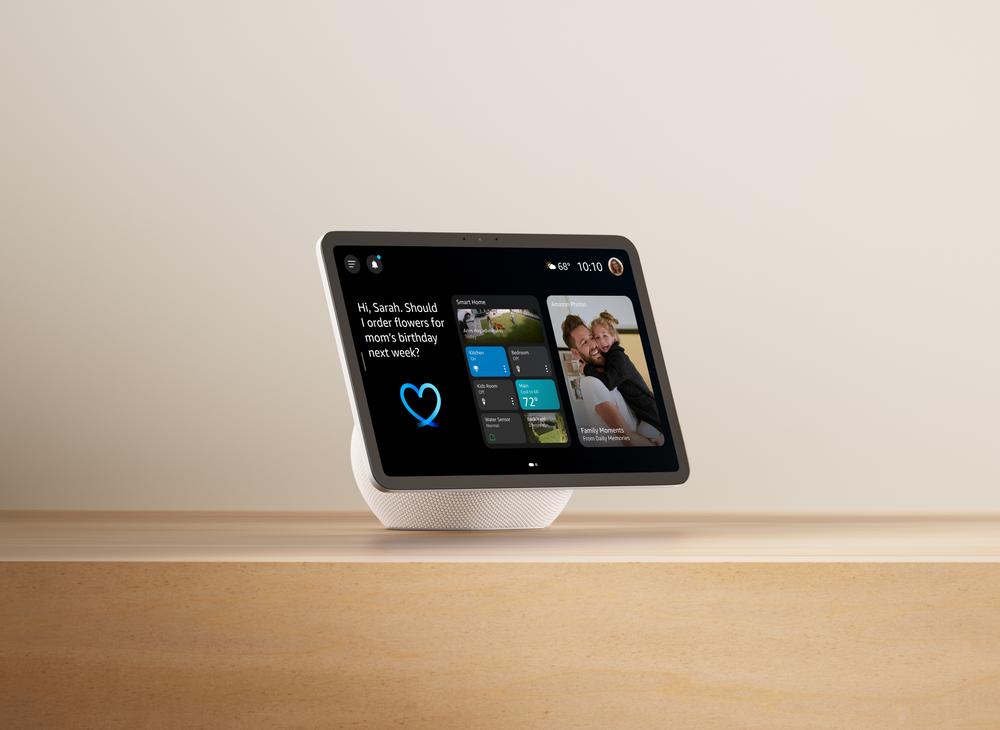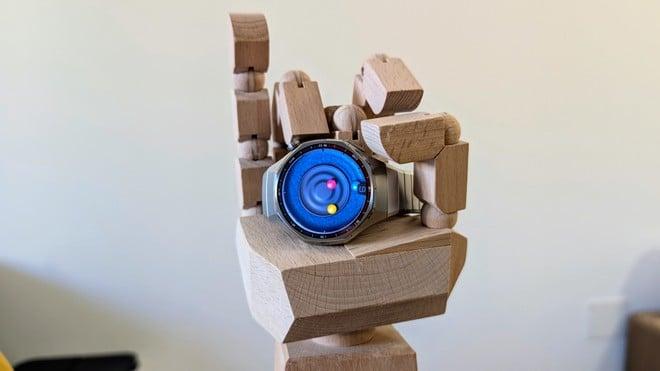Amazon’s newest Echo speakers look gorgeous. Thin bezels, bright, responsive touchscreens, 3D knit fabric-wrapped speakers with controls front and center, and most importantly, powerful hardware to help make the smart home sing. It’s almost everything I’ve ever asked for from my smart speakers and displays.
A lack of premium hardware — or any clear strategy around smart home devices — has long been an issue for Amazon. While practically giving Echo devices away has resulted in an impressive penetration for its Alexa voice assistant, they’re not devices people treasure. They don’t get much respect. These new Echo speakers look set to flip that script, and while they are more expensive, it feels like a minor price bump for a major hardware upgrade.
Today, Amazon launched the Echo Dot Max ($99.99) and a new Echo Studio ($219.99), as well as two new smart displays: the Echo Show 8 ($179.99) and the Echo Show 11 ($219.99). I got hands-on time with the new hardware ahead of the announcements in New York City, and my first impression is that Amazon has finally delivered a polished, powerful lineup — one that could cement Alexa Plus’s early lead as the smart home’s first true AI.
The new Echos are more elegant, have more thoughtful designs (no bright red LEDs when muted), and an attention to detail I didn’t think Amazon was capable of (color-matched cables!). But more importantly, a new family of AZ3 processors means these pack more power and run new edge-based computing capabilities that can process data from a slew of new and improved sensors to make your smart home smarter.
Alexa with a smile
The Echo Dot Max is the clear winner of the new lineup, and the one most people will likely buy. With a new, slightly flattened spherical design, it’s small enough to be unobtrusive but elegant enough not to look out of place. At $99.99, it’s the same price and around the same size as a HomePod Mini.
With a new two-way speaker system, Daniel Rausch, VP of Alexa & Echo, claims it’s “twice as powerful” as Apple’s speaker and produces three times the bass of the current Echo Dot (which is sticking around in the lineup). I didn’t get to hear the new devices ahead of Amazon’s event, but I plan to at the demos today, so will report back.
The biggest design change, along with higher-quality, acoustically transparent, 3D knit fabric, is that the speakers’ controls and LED light ring have been relocated to the front. Rausch says this makes the device more expressive, “You see Alexa listening, thinking, smiling, and responding.” The large, glowing red LED, which appears when the device is muted, is gone, replaced with a small red ring around the mute button.
The new Echo Studio is the heavyweight here, literally. With an all-new design to match the Dot Max, it’s just under half the size of the original Echo Studio, but weighs almost as much. The new form factor should make it easier to find a spot for — helpful if you want to take advantage of the Studio’s 5.1 surround sound capabilities when paired with Fire TV devices. Rausch says it sounds as good as the original, has similar internals, and supports spatial audio and Dolby Atmos.
Alexa, Show me more
It’s the smart displays where Amazon’s hardware has had the biggest upgrade. The thick, laggy touchscreens with giant bezels and bulbous bottoms are gone. The new Echo Show 8 and 11 are more refined, with slim displays perched on an oblong speaker base, wrapped in 3D knit fabric.
The thin displays float in front of the speaker, similar to the Echo Show 10 but more streamlined. This means the screen doesn’t block the speaker, unlike most other Shows, which should allow the sound to reach you better and your voice to reach Alexa more clearly. The screens don’t move, but a magnetic stand (sold separately) adds the option to tilt the device side to side and slightly up and down. I tried this, and it was easy to readjust them with a gentle push with one finger.
These new, custom-built screens have more in common with a high-end tablet than an Echo Show, with thin bezels and clear, bright colors. Rausch says the high-density LCD displays have a contrast ratio better than 1:1000 and increased viewing angles due to fewer layers of lamination.
Aside from size, the primary difference between the 8 and 11 models is that the latter features 1080p resolution, whereas the former has 720p resolution. To my eyes, they both looked light years ahead of the current Echo Shows, and I could see the screen clearly from either side as well as straight on — useful if you’re using it for ambient information like the clock and weather.
To make the displays thinner, Rausch says they used negative LCDs to “reduce layers of lamination and maximize the viewing angle,” and ditched the capacitive touch layer, instead embedding the touch sensors into the display’s pixel structure, which should reduce lag. I got a few swipes and taps in on both displays, and they were super responsive.
A 13-megapixel camera in the center of each display features a wide-angle view to help detect a person sooner and adapt the screen content based on your location and identity (you can enable face match with the Shows and voice match with the speakers for personalized settings). Unfortunately, the physical camera shutter is gone, Rausch says this is to allow for a slimmer bezel. Instead, the mute button now disables both the camera and the microphones, but this lack of a hard visual cut-off won’t appeal to some.
Along with the new displays are upgrades to the Show UI, which launched with Alexa Plus on the Show 21 and 15 earlier this year. A new full-screen smart home panel is designed to make it easier to see and control multiple devices at once, and this interface is also coming to Fire TV, giving you more surfaces for smart home control.
Built for Alexa Plus and the smart home
As I wrote earlier this week, Alexa Plus, Amazon’s new LLM-powered voice assistant, is a significant upgrade over Alexa. But it’s been running on underpowered hardware, which has left me frustrated. Rausch says the new speakers and displays are purpose-built for Alexa Plus and will come with the option to use the new assistant in Early Access out of the box. But more specifically, they’re built for the smart home.
With support for Thread, Matter, and Zigbee smart home protocols (even on the Dot), each of the new devices is a full smart home hub. Additionally, new Wi-Fi sensing presence detection and enhanced ultrasound motion detection capabilities, combined with other on-board sensors and cameras on the Shows, enable these devices to become powerful ambient sensing machines for Alexa Plus.
This is all powered by a new AZ3 custom silicon that adds a neural network accelerator to Amazon’s new Omnisense fusion platform. According to Rausch, this allows the new hardware to process sensor data locally, from both he speakers and any devices connected to Alexa, including cameras.
With this type of ambient data, Alexa Plus could start to better understand, learn, and adapt to your home, laying the groundwork to make Alexa Plus the central brain of your home.
This type of inference could go a long way to unlocking the ambient smart home.
Rausch showed a demo where he asked Alexa what had been happening in his home while he was away. Among other things, Alexa noted that a package had been delivered and that no one had fed the dog. “Don’t forget to feed Rusty. I didn’t notice anyone feeding him today,” it said. Rausch then used this “anomaly,” the fact that something hadn’t happened, as a trigger for an automation, telling Alexa to send a notification any day the dog hasn’t been fed by noon.
Now, it remains to be seen how well this will work in practice, but the promise here is compelling. This type of inference could go a long way to unlocking the ambient smart home, where, instead of you programming a system to do what you want it to do, the system can proactively serve you and alert you to potential problems — bringing us closer to Star Trek’s “Computer.”
For example, you’ve left your garage door open and it’s after 10 pm, so Alexa closes it for you. You haven’t taken the bins out yet, as you do every Tuesday morning, so Alexa makes an announcement. All the household members are gone, but someone is in the living room, so Alexa sends an alert. The potential here is very exciting.
After years of false starts, Amazon may have finally nailed the hardware — and given Alexa the power to take the smart home to the next level.

 Recensione Huawei Watch GT6 Pro: il miglior smartwatch top di gamma?
Recensione Huawei Watch GT6 Pro: il miglior smartwatch top di gamma?